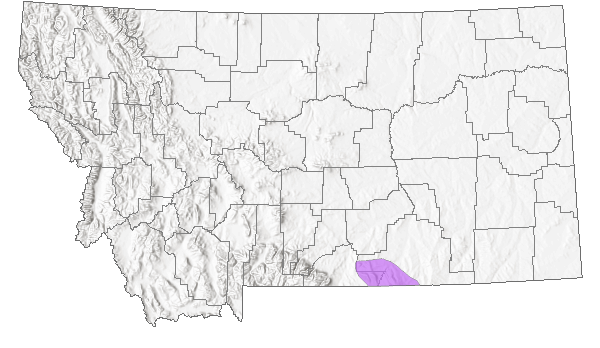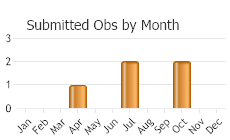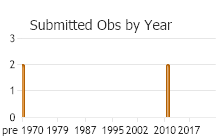View in other NatureServe Network Field Guides
NatureServe
Montana
Utah
Wyoming
Idaho
Wisconsin
British Columbia
South Carolina
Yukon
California
New York
Pygmy Mountainsnail - Oreohelix pygmaea
Other Names:
Oreohelix maculata
General Description
The shell is small to medium, to about 15 mm diameter but usually less than 12 mm, and to 14 mm in height but usually less than 9 mm (ratio of height to diameter 0.67 – 0.81); heliciform with up to 5 1/2 whorls, high-spired in profile, umbilicus narrow and deep, aperture oval, periphery rounded. Shell opaque and chalky, color is brown to fleshy, sometimes chocolate brown on the base (dead sun-bleached shells whitish), with a series of reddish-brown spiral bands, two on the upper surface, a prominent band near the periphery on the lower surface, up to four thinner bands (sometimes none) on the lower surface. Smaller shells may have a brownish cuticle that is lost in larger individuals. Surface is irregularly wrinkled with weak to moderate spiral impressed lines. Suture is deeply impressed on the last whorl (Hendricks 2012, Burke 2013). Internal anatomy is described by Pilsbry (1939).
Diagnostic Characteristics
In the field, best identified based upon a combination of size, narrow umbilicus, location and habitat. Small size, near beehive-shape, and narrow umbilicus distinguish this species from other Oreohelix in Montana. Among the small Oreohelix, O. alpina is found at or above treeline in the western third of the state, O. strigosa berryi has a larger umbilicus and a flatter profile.
Species Range
Montana Range
Range Descriptions

 Native
Native
Range Comments
Northwestern Wyoming and adjacent south-central Montana (Beetle 1987, 1989). In Montana through 2009, two records from two sites east of the Continental Divide in Big Horn County. Elevation range is 1451 to 2006 m (4760 to 6580 ft). Probably also occurs in Carbon County, especially in and around the Pryor Mountains (Hendricks 2012).
Observations in Montana Natural Heritage Program Database
Number of Observations: 5
(Click on the following maps and charts to see full sized version)
Map Help and Descriptions
Relative Density

Recency



 (Observations spanning multiple months or years are excluded from time charts)
(Observations spanning multiple months or years are excluded from time charts)
Habitat
Limestone and sandstone talus, adjacent moist meadows and creek bottoms. Tree canopy species where present include scattered cottonwood, aspen, willow, Douglas-fir, ponderosa pine, juniper and mountain mahogany. Live animals present mostly under rocks and in duff or soil accumulations under rocks, sun-bleached shells may be found on the surface (Beetle 1987, Hendricks 2012).
Reproductive Characteristics
Hermaphroditic (Pilsbry 1939).
Management
The known sites are on private or tribal timberlands, but poorly-defined distribution and habitat needs within Montana makes effective management problematic. None of these sites have special protection. As with many land mollusks, access to moisture is essential, even in arid locations, so favorable conditions include refugia that maintain high humidity and moderate temperatures for at least part of the year. Removal of forest and shrub canopy is likely detrimental.
Stewardship Responsibility
Threats or Limiting Factors
Habitat occupied by Oreohelix pygmaea (low-elevation slopes of open juniper, Ponderosa Pine and Douglas-fir) may be threatened by logging, grazing, weed control, highway development, home development, and fire. The impact of fire retardants on this and other terrestrial mollusks in not known. Little is known about this species, including its susceptibility to disturbance.
References
- Literature Cited AboveLegend:
 View Online Publication
View Online Publication Beetle, D.E. 1987. The genus Oreohelix (Pulmonata: Oreohelicidae) in two western canyons of the Big Horn Mountains, Wyoming. Festivus 19(7):66-72.
Beetle, D.E. 1987. The genus Oreohelix (Pulmonata: Oreohelicidae) in two western canyons of the Big Horn Mountains, Wyoming. Festivus 19(7):66-72. Beetle, D.E. 1989. Checklist of recent Mollusca of Wyoming, U.S.A. The Great Basin Naturalist 49(4):637-645.
Beetle, D.E. 1989. Checklist of recent Mollusca of Wyoming, U.S.A. The Great Basin Naturalist 49(4):637-645. Burke, T. E. 2013. Land snails and slugs of the Pacific Northwest. Corvallis, OR: Oregon State University Press. 344 p.
Burke, T. E. 2013. Land snails and slugs of the Pacific Northwest. Corvallis, OR: Oregon State University Press. 344 p. Hendricks, P. 2012. A Guide to the Land Snails and Slugs of Montana. A report to the U.S. Forest Service - Region 1. Montana Natural Heritage Program, Helena, MT. vii + 187 pp. plus appendices.
Hendricks, P. 2012. A Guide to the Land Snails and Slugs of Montana. A report to the U.S. Forest Service - Region 1. Montana Natural Heritage Program, Helena, MT. vii + 187 pp. plus appendices. Pilsbry, H.A. 1939. Land Mollusca of North America (North of Mexico), Volume 1, Part 1. Monograph of the Academy of Natural Sciences of Philadelphia Monograph Number 3 (1): 1-573.
Pilsbry, H.A. 1939. Land Mollusca of North America (North of Mexico), Volume 1, Part 1. Monograph of the Academy of Natural Sciences of Philadelphia Monograph Number 3 (1): 1-573.
- Additional ReferencesLegend:
 View Online Publication
View Online Publication
Do you know of a citation we're missing? Beetle, D. E. 1961. Mollusca of the Big Horn Mountains. The Nautilus 74:95-102.
Beetle, D. E. 1961. Mollusca of the Big Horn Mountains. The Nautilus 74:95-102. Linscott, T.M., K. Weaver, V. Morales, and C.E. Parent. 2020. Assessing species number and genetic diversity of the Mountainsnails (Oreohelicidae). Conservation Genetics 21:971-985.
Linscott, T.M., K. Weaver, V. Morales, and C.E. Parent. 2020. Assessing species number and genetic diversity of the Mountainsnails (Oreohelicidae). Conservation Genetics 21:971-985.
- Web Search Engines for Articles on "Pygmy Mountainsnail"
- Additional Sources of Information Related to "Snails / Slugs"





